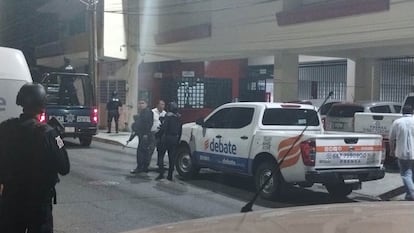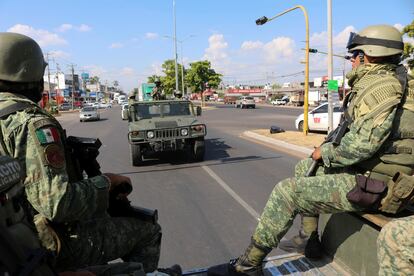The press is experiencing adverse times in Sinaloa. The war unleashed between factions of the Sinaloa Cartel, after the arrest in July of Ismael May Zambada in the United Stateshas put journalism under siege in recent weeks. The direct shooting attack against the newspaper The Debateone of the largest and most important in the State, the kidnapping of a worker from the same media and the threats that have been on the rise in recent times have put the union of this entity on alert. Several journalists and defenders tell EL PAÍS about the fear and uncertainty when it comes to going out to work.
The key date was September 9. That Monday, it broke out in Sinaloa a wave of violence without recent precedents. The alleged betrayal of one of Joaquín’s sons El Chapo Guzmán, Joaquín Guzmán López, to Zambada, by handing him over to the US authorities, broke a balance that had reigned for years in Culiacán. Until then, the two factions coexisted almost without problems in the capital of Sinaloa. But the breaking of that “unwritten code,” says a local reporter who does not want to give his name for security reasons, led to the war that has shaken the entity since then.
In the middle of that struggle, the journalists were then left, several voices explain to this newspaper. “We are experiencing a complicated situation due to the division within the Sinaloa Cartel,” says Jesús Bustamente, president of the June 7 Journalists Association. “We have nothing to do with it, but we have the duty to tell what is happening.” The increase in clashes between factions of organized crime caused an increase in intimidation against the union, threats, and blockades to access the areas where acts of violence were recorded. “All of this became more visible with the attack on “The Debate”he adds.

On October 17, after 10:30 p.m., the headquarters of The Debatein the center of Culiacán, was attacked with bullets by a person who got out of a car with a long weapon. The vehicle had been hovering around the media outlet for some time, and when the attacker fired at the façade, two journalists who were at the door managed to run and lie down to dodge the bullets. The bulleted entrance is the one the staff uses to enter and exit, explains Gustavo Lizárraga, the newspaper’s web editor in Sinaloa, and at that time there are usually a lot of people. That day some colleagues had just managed to leave, leaving minutes before the attack. No one was hurt, but “the fear that that leaves behind doesn’t go away,” he says.
Less than two days later, this media outlet suffered another attack. A delivery driver carrying the printed editions of the newspaper on his motorcycle was chased, attacked and kidnapped by armed criminals early last Saturday. Since then, his colleagues and family have not heard from him. “I hope that the people who took him will have compassion and release him,” says Lizárraga. The photographs released after the attack on the delivery driver showed the newspapers scattered next to his vehicle, with no sign of the worker. For the other media, these two attacks are a message of the crime to the entire union. “By attacking a highly recognized media outlet with bullets, they put everyone on alert,” says Bustamante. “It is a warning to others.”
When it was unleashed the wave of violence at the beginning of Septemberthe press began to notice signs that coverage was going to be complicated, explains Bustamante. In the previous months, if they asked criminal groups for permission to enter a red zone, they could do so. But recently, when they tried to access areas where the clashes were taking place, the members of the cartel prevented them from passing and warned them not to publish anything about what was happening in certain municipalities, says the defender. This led journalists to stop entering rural areas, abandoning coverage so as not to expose themselves. “We are limiting ourselves to telling what happens within the city because there is no safe way to reach those municipalities,” he comments.
At least three reporters who prefer not to give their names said they now take extra precautions to do their jobs. Do not go out at night, do not go alone to coverage, sometimes even not identify yourself as a journalist. “The press is living in a context of fear,” says the web editor of The Debate. “We’re trying to understand what the limits are so that the content you write doesn’t get you in trouble.” The newspaper’s editorial staff these days has protection from the National Guard and the state police, but they do not know how long it will last.
Jhenny Bernal Arellano, director of the Institute for the Protection of Human Rights Defenders and Journalists of Sinaloa, admits that the most affected are the red notice reporters and that, in the last month and a half, complaints of attacks on the reporters. “The climate of violence persists, we have had several events that keep us on alert,” he says in a telephone interview. The authorities have tried to make light of the situation, which continues to worsen as the weeks go by. “Every action is too small to guarantee the work of the press,” he adds.
For Bernal, what the entity experiences It is “extraordinary violence” because, despite normally having adverse conditions, what is happening now is extreme. Another local reporter, who also does not want to give his name, says that “something like this has never happened.” Several journalists remember the time of struggle between the Sinaloa Cartel and the Beltrán Leyva as the last major conflict they went through, which began in 2008 and ended almost two years later. At that time, the weekly Ríodoce suffered an attack when two attackers threw a grenade at the editorial office.

The experiences learned at that time, however, do not remove today’s fears. Reporters no longer fight over who has the exclusive, who gets to the scene first, or who publishes what happened before anyone else. They have chosen to abandon competition and prioritize safety. “The conditions are very difficult, but if we stop working we lose our essence,” says the web editor of The Debate. “The journalist in Sinaloa is not that he is brave, it is that he has learned to work with fear.”

